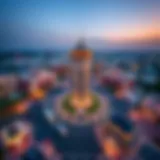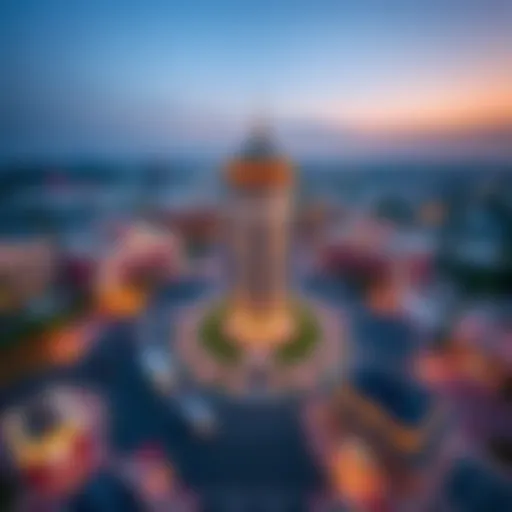Lighting the Burj Khalifa: An In-Depth Look


Intro
The Burj Khalifa is not just an architectural marvel; it serves as a beacon of modern ingenuity and a canvas for artistic illumination. Towering majestically over Dubai, this iconic skyscraper elegantly changes colors and designs with each passing night. Its lighting, a crucial aspect of its identity, reflects cultural celebrations, corporate achievements, and artistic displays. But beyond mere beauty, the illumination of the Burj Khalifa plays a significant role in the environment, psychological well-being, and even the economy of the surrounding area.
It's fascinating to delve into how this skyscraper's lights are programmed to dance to various themes providing an unforgettable spectacle. The lights themselves are a high-tech combination of LEDs and projection technology, ensuring vibrant displays that can be seen from miles away. For investors and developers, understanding this lighting strategy unveils insights into how such a feature can enhance property values and influence the appeal of the neighborhood.
In the following sections, we will take a closer look at the lighting schedule and its significance, the technology behind such breathtaking displays, and special events that make the illumination of Burj Khalifa a crucial part of Dubai's skyline. From property trends to investment opportunities related to this iconic structure, there is much to explore and understand. Whether you are a seasoned investor or just a curious traveler, this exploration will shed light on how the Burj Khalifa's illumination syncs with the vibrant life of a city that never sleeps.
Prologue to the Burj Khalifa
The Burj Khalifa stands as a monumental edifice, not just as the tallest structure in the world, but also as a symbol of modern architectural ambition. Located in the heart of Dubai, this towering skyscraper boasts not only remarkable height but also a myriad of other features that highlight its significance in the realm of real estate and cultural identity. Understanding the Burj Khalifa's stature is fundamental to grasping the broader implications of its illumination, which we will delve into further.
Overview of the Structure
Standing at an astonishing height of 828 meters, the Burj Khalifa features 163 floors and a plethora of luxury amenities. It houses offices, residences, dining establishments, and observation decks that offer breathtaking views of the city skyline. The structure is a fusion of art and engineering, designed by the acclaimed architectural firm Skidmore, Owings & Merrill. The building’s unique design, reminiscent of the Hymenocallis flower, not only contributes to aesthetic values but also addresses wind resistance—a crucial consideration for towers of this scale. The careful attention to detail in its form and function asserts its position as a pioneering structure of the 21st century.
Architectural Significance
The architectural brilliance of the Burj Khalifa goes beyond its impressive measurements. It stands as a beacon of innovation, pushing boundaries in construction technology. The building’s intricate facade, made of reflective glazing and metallic elements, ensures energy efficiency while providing an ever-changing visual interaction with sunlight. This aspect is especially noteworthy when considering the lighting schemes employed: they enhance its design while adding a sense of dynamism to the Dubai skyline.
In terms of cultural significance, the Burj Khalifa embodies the aspirations of a city known for its luxury and futuristic vision. Its illumination at night transforms it into a canvas of light and color, engaging viewers emotionally and psychologically. This interplay between structure and light not only elevates the building's prominence but also reaffirms Dubai's image as an epicenter of innovation and tourism.
"The Burj Khalifa is a testament to human ingenuity, showcasing how design and technology can harmoniously coexist to redefine urban landscapes."
Thus, as we explore the illumination of the Burj Khalifa, we will reveal how it encapsulates the essence of this architectural marvel and reflects the spirit of Dubai. The subsequent sections will further illuminate its lighting schedule, technical aspects, cultural relevance, and its substantial impact on tourism and city identity.
Lighting Schedule Overview
The illumination of the Burj Khalifa is not just about aesthetics, it embodies a carefully choreographed performance of light that captivates locals and tourists alike. Understanding the lighting schedule serves as a window into the purpose and function of this architectural wonder. It highlights the interrelationship between the building and its surrounding environment, influencing both daily experiences and broader cultural practices.
The lighting schedule allows for a dynamic representation of events and festivities, making it a vital aspect of the Burj Khalifa’s identity. It showcases the building’s versatility while enhancing its visibility in Dubai's vibrant skyline. Here are some key elements to consider regarding the lighting schedule:
- Aesthetic Appeal: The structured light patterns create beautiful visuals, turning the Burj Khalifa into a living entity that interacts with observers.
- Cultural Significance: Each lighting display often corresponds to various local and global celebrations, reflecting heritage and values.
- Visitor Experience: For tourists, witnessing the illumination becomes a memorable part of their visit.
- Economic Impact: By attracting visitors during special displays, the volume of tourism increases, which can benefit local businesses.
In essence, the lighting schedule does not merely serve to illuminate; it breathes life into the Burj Khalifa and engages all who gaze upon it.
Daily Lighting Patterns
Each day, the lighting of the Burj Khalifa follows a structured routine that offers a blend of solid colors and dynamic patterns. In the early evening, as dusk settles, the lights come to life, showcasing a program designed to captivate onlookers.
The patterns vary, but a general format can be observed:
- Standard Lighting: During routine nights, the building usually displays a soft, elegant glow using white and blue tones.
- Theme Nights: Frequently, the tower adopts colors associated with particular events or gestures. For example, during World Health Day, green hues might dominate.
- Interactive Displays: Certain nights may feature synchronized light shows, where lights dance across the façade in harmony with music.
This intricate ballet of lights not only creates a mesmerizing spectacle but also showcases the Burj Khalifa as a backdrop for the Dubai lifestyle, joining in the everyday hustle of the city.
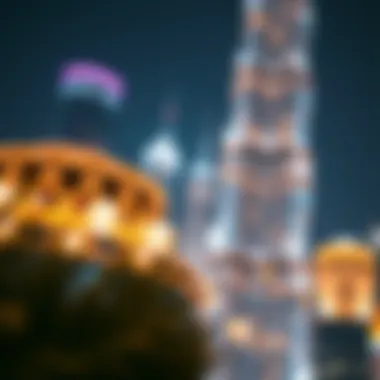

Seasonal Variations
The change of seasons also brings a new flavor to the Burj Khalifa's illumination. As the year progresses, different holidays and events are celebrated through variations in the lighting scheme.
- Winter Festivities: In December, the tower often lights up in festive colors, embodying the spirit of the season.
- National Holidays: Events like UAE National Day result in grand displays, with the building lit in the colors of the national flag.
- Cultural Events: During Ramadan, the lighting might reflect Islamic motifs, creating an ambiance of reflection and spirituality.
This seasonal adaptability not only keeps the interest alive among locals and visitors but also strengthens the Burj Khalifa's role as a symbol of unity and celebration within Dubai's diverse cultural landscape. Each display resonates with deeper meanings, celebrating both the site’s architectural majesty and its importance to the community.
The Burj Khalifa’s illumination is a testament to Dubai’s spirit, blending traditional values with modern expression.
This orchestration offers insights into how the structure engages with its fans, turning the Burj Khalifa into a monument not only of height but also of heart.
Significance of Burj Khalifa's Illumination
The illumination of the Burj Khalifa is not merely about aesthetics; it embodies a fusion of cultural significance and economic vitality in Dubai. As the tallest building in the world, its radiant lights serve as a beacon that draws attention from all corners of the globe. This illumination represents a bridge between modernity and tradition, and it plays a crucial role in the identity of the city.
Cultural Importance
The Burj Khalifa's illumination resonates with cultural narratives that are ingrained in Dubai's spirit. Each light display tells a story, integrating themes from local heritage, international festivities, and significant national events. For instance, during the holy month of Ramadan, the building often features soft, warm lights that evoke a sense of reflection and spirituality. On the other hand, during major events like the National Day, the lighting transforms to showcase the vibrant colors of the UAE flag, amplifying national pride among citizens and expatriates alike.
Moreover, the marriage of art and technology is glaringly evident in the Burj Khalifa's nightly illuminations. The light shows are often choreographed with music and projections, enthralling audiences with a multisensory experience. This not only enhances the architectural beauty but also weaves a deeper connection to the cultural fabric of Dubai. Tourists gather in large numbers to witness these shows, making it a highlight of their visit and fostering a sense of community as they share in the moment.
Tourism and Economic Impact
When delving into the economic implications of the Burj Khalifa's lighting, the numbers can be startling. The light displays attract millions of visitors every year, significantly bolstering the hospitality and service industries. According to various studies, tourism in Dubai has seen considerable growth, driven largely by landmark attractions such as the Burj Khalifa. Packages for tourists to visit the observation decks often include the stunning light show, adding value to their overall experience.
Moreover, businesses surrounding the Burj Khalifa also reap the benefits of this attraction. Restaurants, shops, and entertainment venues see increased patronage during light shows, creating a thriving local economy. Events like New Year’s Eve, where the Burj dazzles with an extravagant display, contribute to an influx of tourists, helping local businesses flourish.
"The illumination of the Burj Khalifa doesn't just light up the skyline; it ignites the spirit of Dubai as a whole, drawing people together and fueling economic growth."
Investing in the maintenance and evolution of these lighting displays is equally vital. The advancements in lighting technology enhance not only the experience but also align with Dubai's broader vision of becoming a global innovation hub. By prioritizing energy-efficient lighting, the Burj Khalifa sets an example for sustainability while reinforcing its role as a symbol of progress.
In summary, the significance of the Burj Khalifa's illumination transcends mere decoration. It plays an essential part in Dubai's cultural landscape and economic framework, drawing together people from various backgrounds and creating a lasting impression that contributes to the city's global status.
Key Events and Celebrations
The Burj Khalifa stands not just as a marvel of engineering but as a symbol of celebration and cultural significance in Dubai. The illumination of this towering structure during key events captures the essence of the city's spirit. Each occasion presents a unique opportunity to showcase creativity through light and color, drawing locals and tourists alike to witness these spectacular displays. Understanding the events that ignite these illuminations offers valuable insights into the city's identity and the building's role as a beacon of unity and festivity.
New Year Celebrations
New Year’s Eve at the Burj Khalifa is nothing short of legendary. Each year, the pinnacle of Dubai’s celebrations centers around this architectural giant. The fireworks display, synchronized with an elaborate light show, transforms the skyline into a dazzling canvas. Thousands gather in the surrounding areas, attesting to the spectacle's magnetism.
The countdown leading to midnight is as much about anticipation as it is about tradition. An electric atmosphere grips the crowd as the lights pulse in time with the heartbeat of the city. Notably, the displays tend to blend themes of hope, renewal, and unity, reflecting the aspirations of the attendees. The lighting not only enhances the spectacle but serves to elevate spirits, making the Burj Khalifa the focal point of unity and celebration.
National Holidays
During national holidays, the Burj Khalifa plays a key role in fostering national pride. From UAE's National Day to Eid festivities, its illuminations take on special significance. Each holiday is celebrated with thematic colors, designs, and messages, reinforcing cultural values and traditions.
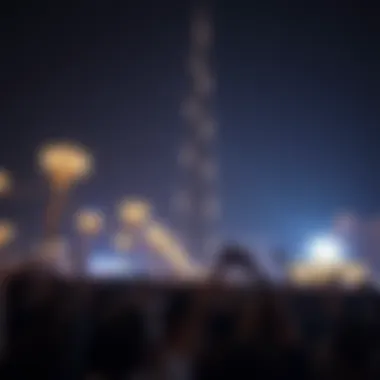

For instance, on National Day, the tower is often lit up in red, green, white, and black, mirroring the colors of the nation’s flag. This display is more than mere decoration; it’s a resonance of the collective identity of the people. Feedback from local residents highlights a sense of connection and belonging each time their national symbols are reflected on such an iconic structure. This relationship between the building and the community shapes Dubai’s cultural landscape.
Special Anniversaries
Special anniversaries mark pivotal moments for both the Burj Khalifa and the city itself. When celebrating milestones such as the completion of the building or anniversaries of significant events in Dubai’s history, the architectural giant becomes a stage for storytelling.
The lighting can change, depicting scenes or patterns that tell a story of progress and achievement. In certain instances, collaborations with artists have led to extraordinary artistic displays, merging light with innovative storytelling techniques. Attendees often describe the experience as immersive, engaging them in a dialogue between culture and modernity. The feedback from those who witness such displays often revolves around the sense of pride and excitement they kindle in the community.
The luminous celebrations at the Burj Khalifa are not just events; they are a canvas reflecting the city’s joy, spirit, and heart. These occasions forge connections within the community and invite the world to share in Dubai’s narrative of growth, unity, and joy.
Technical Aspects of the Lighting System
The lighting system of the Burj Khalifa stands as a testament to innovation and design, intertwining technology with artistry to accentuate its monumental stature. Understanding the technical aspects of the lighting system is crucial as it sheds light—quite literally—on how such an iconic structure is able to engage and mesmerize millions. It encompasses intricate technologies, efficiency measures, and overall system design that contribute to its dazzling displays.
Lighting Technology Used
The heart of Burj Khalifa's illumination lies in its cutting-edge lighting technology. The primary components include:
- LED Lighting: The use of LED lights offers flexibility in color and dynamic effects, allowing the tower to change hues and themes with ease. This technology consumes less power than traditional lighting while enhancing brightness and clarity.
- Dynamic Control Systems: Integrated control systems permit programmers to set complex lighting sequences for different events, from holidays to specific celebrations. This scalability ensures that the lighting can be tailored for any occasion without excessive manual intervention.
- High-Performance Luminaires: LED luminaires, specifically engineered for high-rise applications, provide superior optical performance, ensuring that light distribution is both efficient and effective at all heights.
This blend of technology provides not just functionality, but an evolving visual experience that speaks to the vibrant culture of Dubai. Using this technology, the Burj Khalifa transforms into a canvas of light, illustrating cultural themes that resonate with its diverse audience.
Energy Efficiency Measures
In an era where sustainability is more than a buzzword, Burj Khalifa stands at the forefront of energy efficiency. The lighting system underscores this commitment through several measures:
- Smart Controls: The incorporation of smart lighting controls minimizes energy waste. The system can automatically adjust lighting based on natural light conditions, ensuring that illumination is only used when truly necessary.
- Solar Energy Integration: There are plans to integrate solar energy into the lighting system, allowing the building to harness renewable energy and reduce its carbon footprint.
- Maintenance of Optimal Energy Use: Regular assessments and upgrades to the lighting system ensure that the energy consumption levels remain at their optimum, while the longevity of lights decreases maintenance costs over time.
"Sustainability is not just about reducing consumption; it’s about integrating practices that benefit the environment while enhancing the visual appeal."
This philosophy is reflected in the Burj Khalifa's design choices, not only making it an architectural marvel but also a model of responsible urban infrastructure.
As we navigate the future of Burj Khalifa's lighting installations, the technology and efficiency measures serve as a lens through which we can view the intricate balance between aesthetics and responsibility in modern architectural lighting.
Public Reception of the Illuminations
The public reception of the Burj Khalifa's illuminations is a rich tapestry of local sentiment and global curiosity that shapes the identity of this iconic structure. Understanding how these lights are perceived is pivotal, considering their significance not only for aesthetic enjoyment but also for tourism and local pride. Reviews vary between admiration and skepticism, reflecting the diverse views of those who experience this towering masterpiece.
Local Perspectives
Locals often regard the Burj Khalifa's lighting as a vital element of Dubai's cultural landscape. For many residents, the light displays are more than just a spectacle; they represent a narrative of progress and aspiration. When the Burj Khalifa lights up at night, families gather at nearby parks or waterfronts to witness the dazzling display, making it a communal experience.
The architectural marvel inspires a sense of ownership among Dubai's citizens. "It’s not just a building—it’s part of our story," expresses a long-time resident, emphasizing the emotional connection to the structures that symbolize the city's rapid development. In this way, the illuminations embody a bridge between a glorious past and a promising future.
Public events often take center stage, with residents taking to social media to share their thoughts and experiences. Videos and photographs of the vibrant light shows circulate widely, creating a sense of community pride. Additionally, local feedback can play a vital role in influencing the themes and designs of the light shows, making the displays more reflective of the cultural dynamics of Dubai.
Tourist Experiences
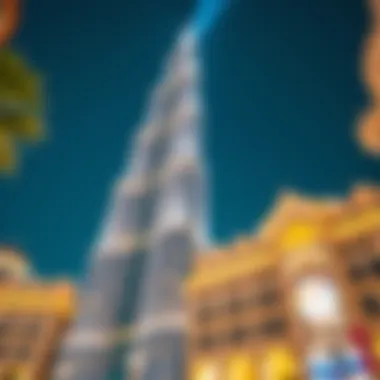

For tourists, the Burj Khalifa is often a bucket-list destination, and the illuminations are a crowning experience. Many visitors plan their trips specifically around the light displays, which are sometimes accompanied by musical performances or seasonal festivities. The combination of breathtaking visuals and the towering presence of the building creates a unique experience that is hard to match elsewhere.
Observers frequently express awe when exposed to the grandeur of the illuminations. Passport holders from a wide array of countries often document their experiences via social media, leaving behind a trail of enthusiastic comments. Their shared narratives feed into a cycle of fascination, attracting even more visitors year after year.
From an economic perspective, these light displays bolster tourism revenue significantly. Tour companies have begun offering tailored experiences that include light show viewing combined with dining or cultural tours. It’s a win-win for both sectors: the tourists get an unforgettable experience, and the city reaps the economic benefits.
Tourist reviews frequently highlight the Burj Khalifa as a symbol of luxury and innovation. "It’s not just seeing the tallest building; it's about feeling the pulse of a city that never sleeps," one traveler notes, revealing how the illuminations contribute to the overall impression of Dubai.
In essence, the public reception of the Burj Khalifa's illuminations reflects a complex interplay of local identity and global appeal, signifying much more than mere lights against a skyline; they tell a story that resonates with diverse audiences.
The lights of the Burj Khalifa are not merely aesthetic choices; they are symbols that resonate profoundly with those who view them. For locals, they signify community pride and regional identity, while for tourists, they present an unforgettable glimpse into the heart of Dubai.
Future Lighting Projects and Plans
The future of lighting at the Burj Khalifa is not just a matter of aesthetics but also a significant element in maintaining its status as a cultural and architectural icon. As technology evolves, so does the potential for more sophisticated and sustainable lighting strategies that can enhance the structure's visual appeal while meeting modern environmental standards. Let's delve into some key areas concerning the future lighting projects and plans for this awe-inspiring skyscraper.
Innovations on the Horizon
The Burj Khalifa has always been a beacon of innovation, and the lighting systems are no exception. Recent advancements in LED technology are paving the way for more vibrant colors and dynamic displays.
- Adaptive Lighting: Future projects may involve adaptive lighting systems that change based on environmental conditions such as weather or time of day. This not only improves the aesthetic but also helps in energy conservation.
- Interactive Displays: Imagine a scenario where the light displays respond to events or even the moods of the onlookers. This could be realized using sensors that gauge the crowd's emotions and adjust the lighting accordingly.
- Enhanced Projection Mapping: By integrating cutting-edge projection mapping techniques, the Burj Khalifa can tell stories through light, advancing beyond static images to include dynamic, visually stunning narratives that engage visitors.
"Innovation in light will not just enhance visibility, it will transform the Burj Khalifa into an interactive canvas that reflects the pulse of the city."
These innovations are not merely whimsical; they are positioned to spark more interest in the region, making a visit to the Burj Khalifa a more engaging and memorable experience for tourists and locals alike.
Sustainability Initiatives
With climate change becoming an increasingly urgent global issue, future lighting projects at the Burj Khalifa will prioritize sustainability. Lighting solutions are being designed with an acute awareness of the need to reduce energy consumption and environmental impact.
- Solar-Powered Lighting: One idea that has gained traction is the incorporation of solar panels to power lighting systems. Harnessing solar energy can significantly lessen the building's carbon footprint while ensuring the lights shine brightly without reliance on fossil fuels.
- Smart Lighting Controls: Implementing smart configurations that adjust the brightness and color of lights based on real-time data can save a substantial amount of energy. This technology uses algorithms to determine when lighting is necessary, ensuring that lights are not used unnecessarily, especially during off-peak hours.
- Recycling and Maintenance: There are also plans in the pipeline to use materials that minimize waste. This includes utilizing recyclable products for the lighting fixtures and ensuring that those materials are easy to maintain and replace, further stretching their lifespan and reducing the need for frequent renewals.
These sustainability initiatives not only represent a commitment to preserving the environment but also serve to enhance the Burj Khalifa's image as a progressive, forward-thinking structure. Investors and planners seeking to align themselves with environmentally conscious projects will find these plans particularly appealing.
Ultimately, the future of the Burj Khalifa's lighting is a testament to an ongoing evolution, merging technology and sustainability with the grand vision of an iconic skyline.
Culmination
The illumination of the Burj Khalifa serves as more than just a visual spectacle; it encapsulates the spirit of Dubai and the ingenuity of modern architectural design. This final section synthesizes the overarching themes explored throughout the article, emphasizing the significant aspects surrounding the lighting of this tallest structure in the world.
Summary of Key Insights
A thorough examination has led to several key takeaways:
- Dynamic Lighting Design: The Burj Khalifa's lighting scheme is known for its responsiveness to various cultural events, contributing to the visual narrative of urban life in Dubai.
- Tourism Enhancement: The lighting display not only draws tourists but also boosts local economies, making it a vital component in enhancing Dubai’s global identity.
- Technological Advancements: The combination of state-of-the-art technology with sustainable practices in the lighting system highlights the city’s commitment to innovation and environmental responsibility.
These insights reflect how the Burj Khalifa stands as a beacon of contemporary architecture, harmonizing aesthetic allure with technological prowess.
The Burj Khalifa's Role in Dubai's Identity
Located at the heart of Dubai, the Burj Khalifa is more than an architectural marvel; it is a symbol of the city’s ambition and growth. Illuminated at night, it transforms into a vibrant emblem of culture and creativity, embodying the essence of a city that strives for excellence.
Moreover, the building has redefined the urban skyline, becoming synonymous with Dubai's identity on a global stage. Its illumination schemes often narrate local stories or commemorate significant events, weaving a narrative that connects past and present. From attracting attention during international celebrations to fostering community pride, the Burj Khalifa's lights symbolize unity, progress, and the ever-evolving character of Dubai.






